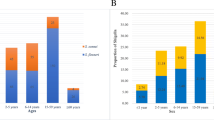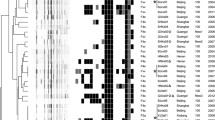Abstract
Objective: To provide the epidemiology, resistance pattern, and characterization of integrons in Shigella flexneri isolated between 2001 and 2011 in Jiangsu Province. Method: A total of 624 strains of S. flexneri were collected from both outpatients and inpatients in hospitals in Jiangsu Province from January 2001 to December 2011. The Kirby–Bauer disk diffusion method was used to perform the antimicrobial susceptibility test. Polymerase chain reaction (PCR) was used in the detection of integrons. Pulsed-field gel electrophoresis (PFGE) was applied in the homology studies. Result: Serotype 2a accounted for the largest proportion in S. flexneri, namely 26.4 %. Notably, an increasing trend was detected in the resistance to common antimicrobial agents during the period 2001–2011. In recent years, more than 80.0 % isolates of S. flexneri have proved to be resistant to ampicillin, nalidixic acid, and tetracycline. The positive rates of class 1, class 2, and the atypical class 1 integrons in S. flexneri are 69.3 %, 87.8 %, and 89.2 % respectively. Most integrons detected in our research carry genes encoding resistance to trimethoprim and streptomycin. Conclusion: Antimicrobial resistance in S. flexneri has demonstrated a continuous rising trend in Jiangsu Province. A high prevalence of integrons and gene cassettes play an important role in the transmission of drug resistance in S. flexneri. Effective measures are urgently needed to control the spread of multi-drug-resistant S. flexneri, and more continuing active surveillance of antimicrobial resistance should be established worldwide, especially in developing countries.



Similar content being viewed by others
References
Sur D, Ramamurthy T, Deen J, Bhattacharya SK (2004) Shigellosis: challenges & management issues. Indian J Med Res 120:454–462. doi:10.1099/jmm.0.022517-0
Bing G, Cao Y, Pan S et al (2012) Comparison of the prevalence and changing resistance to nalidixic acid and ciprofloxacin of Shigella between Europe–America and Asia–Africa from1998 to 2009. Int J Antimicrob Agents 40:9–17. doi:10.1016/j.ijantimicag
Sui J, Zhang J, Sun J, Chang Z, Zhang W, Wang Z (2010) Surveillance of bacillary dysentery in China. Dis Surv 25:947–950
Ke X, Gu B, Pan S, Tong M (2011) Epidemiology and molecular mechanism of integron-mediated antibiotic resistance in Shigella. Arch Microbiol 193:767–774. doi:10.1007/s00203-011-0744-3
Pan JC, Ye R, Meng DM, Zhang W, Wang HQ, Liu KZ (2006) Molecular characteristics of class 1 and class 2 integrons and their relationships to antibiotic resistance in clinical isolates of Shigella sonnei and Shigella flexneri. J Antimicrob Chemother 58:288–296
Clinical and Laboratory Standards Institute (2012) Performance standards for antimicrobial susceptibility testing; 22th information supplement. M100-S22
Gu B, Pan S, Wang T et al (2008) Novel cassette arrays of integrons in clinical strains of Enterobacteriaceae in China. Int J Antimicrob Agents 32:529–533. doi:10.1016/j.ijantimicag.2008.06.019
Zhang W, Luo Y, Li J et al (2011) Wide dissemination of multidrug resistant Shigella isolates in China. J Antimicrob Chemother 66:2527–2535. doi:10.1093/jac/dkr341.9
Bangtrakulnonth A, Vieira AR, Lo Fo Wong DM et al (2008) Shigella from humans in Thailand during 1993 to 2006: spatial–time trends in species and serotype distribution. Foodborne Pathog Dis 5:773–784. doi:10.1089/fpd.2008.0109
Pazhani GP, Ramamurthy T, Mitra U, Bhattacharya SK, Niyogi SK (2005) Species diversity and antimicrobial resistance of Shigella spp. isolated between 2001 and 2004 from hospitalized children with diarrhoea in Kolkata (Calcutta), India. Epidemiol Infect 133:1089–1095
Qiu S, Xu X, Yang C et al (2014) Shift in serotype distribution of Shigella species in China, 2003–2013. Clin Microbiol Infect 21:e5–e8. doi:10.1016/j.cmi.2014.10.019
Das SK, Ahmed S, Ferdous F (2013) Changing emergence of Shigella sero groups in Bangladesh: observation from four different diarrheal disease hospitals. PLoS One 29:e62029. doi:10.1371/journal.pone.0062029
Vinh H, Nhu NT, Nga TV et al (2009) A changing picture of shigellosis in southern Vietnam: shifting species dominance, antimicrobialsusceptibility and clinical presentation. BMC Infect Dis 9:204–215. doi:10.1186/1471-2334-9-204
Von Seidlein L, Kim DR, Ali M et al (2006) A multicentre study of Shigella diarrhoea in six Asian countries: disease burden, clinical mani-festations, and microbiology. PLoS Med 3:e353
Chang Z, Lu S, Chen L, Jin Q, Yang J (2012) Causative species and serotypes of shigellosis in mainland China: systematic review and meta-analysis. PLoS One 7:e52515. doi:10.1371/journal.pone.0052515
Xia S, Xu B, Huang L et al (2011) Prevalence and characterization of human Shigella infections in Henan Province, China, in 2006. J Clin Microbiol 49:232–242. doi:10.1128/JCM.01508-10
Ye C, Lan R, Xia S et al (2010) Emergence of a new multidrug-resistant serotype X variant in an epidemic clone of Shigella flexneri. J Clin Microbiol 48:419–426. doi:10.1128/JCM.0061-09
Pryamukhina NS, Khomenko NA (1988) Suggestion to supplement Shigella flexneri classification scheme with the subserovar Shigella flexneri 4c: phenotypic characteristics of strains. J Clin Microbiol 26:1147–1149
Youai T (2005) Identification of an isolate of X variant S. flexneri. Jiangsu Prev Med 16:11–12
Hui G, Jinchuan Y (2004) Analysis of 12 isolates of X variant S. flexneri. Chin Prev Med 5:405–406
Deng Y, Bao X, Ji L et al (2015) Resistance integrons: class 1, 2 and 3 integrons. Ann Clin Microbiol Antimicrob 14:45–55. doi:10.1186/s12941-015-0100-6
Nógrády N, Király M, Borbás K, Tóth Á, Pászti J, Tóth I (2013) Antimicrobial resistance and genetic characteristics of integroncarrier shigellae isolated in Hungary (1998–2008). J Med Microbiol 62:1545–1551. doi:10.1099/jmm.0.058917-0
Madiyarov RS, Bektemirov AM, Ibadova GA et al (2010) Antimicrobial resistance patterns and prevalence of class 1 and 2 integrons in Shigella flexneri and Shigellasonnei isolated in Uzbekistan. Gut Pathog 9:18. doi:10.1186/1757-4749-2-18
Abd-Elmeged GM, Khairy RM, Abo-Eloyoon SM, Abdelwahab SF (2015) Changing patterns of drug-resistant Shigella isolates in Egypt. Microb Drug Resist 21:286–291. doi:10.1089/mdr.2014.0187
Mates A, Eyny D, Philo S (2000) Antimicrobial resistance trends in Shigella serogroups isolated in Israel, 1990–1995. Eur J Clin Microbiol Infect Dis 19:108–111
White PA, McIver CJ, Rawlinson WD (2001) Integrons and gene cassettes in the Enterobacteriaceae. Antimicrob Agents Chemother 45:2658–2661. doi:10.1128/AAC.45.9.2658-2661.2001
Partridge SR, Tsafnat G, Coiera E, Iredell JR (2009) Gene cassettes and cassette arrays in mobile resistance integrons. FEMS Microbiol Rev 33:757–784. doi:10.1111/j.1574-6976.2009.00175.x
Sundström L (1998) The potential of integrons and connected programmed rearrangements for mediating horizontal genetransfer. APMIS Suppl 84:37–42
Benny E, Mesere K, Pavlin BI (2014) A large outbreak of shigellosis commencing in an internally displaced population, Papua New Guinea, 2013. Western Pac Surveill Response J 15:18–21. doi:10.5365/WPSAR.2014.5.2.003
Della Gaspera A, Caffer MI, Panagópulo M et al (2015) Shigelosis outbreak in the city of Lujan, Argentina. Rev Argent Microbiol 47:112–117. doi:10.1016/j.ram.2015.02.003
Zhang W, Pan JC, Meng DM, Ye R, Wang HQ (2007) PFGE of Shigella flexneri 4c isolates from food-poisoning outbreaks and sporadic diarrhea patients. Zhonghua Yu Fang Yi Xue Za Zhi 41:50–53. doi:10.3760/j:issn:0253–9624.2007.01.013
He F, Han K, Liu L et al (2012) Shigellosis outbreak associated with contaminated well water in a rural elementary school: Sichuan Province, China. PLoS One 7:e47239. doi:10.1371/journal.pone.0047239
Chang CY, Lu PL, Lin CC, Lee TM, Tsai MY, Chang LL (2011) Integron types, gene cassettes, antimicrobial resistance genes and plasmids of Shigella sonnei isolates from outbreaks and sporadic cases in Taiwan. J Med Microbiol 60:197–204. doi:10.1099/jmm.0.022517-0
Author information
Authors and Affiliations
Corresponding authors
Ethics declarations
Funding
This research was funded by National Natural Science Foundation of China (81000754, 81471994), Natural Science Foundation of Jiangsu Province (BK20151154), and a youth science and technology innovation team project of Xuzhou Medical University in 2015.
Conflict of interest
The authors declare no conflict of interest.
Ethical approval
No human participants or animals are involved in this research.
Additional information
Y. Xu and L. Zhuang contributed equally to this work.
Electronic supplementary material
Below is the link to the electronic supplementary material.
ESM 1
(DOCX 2067 kb)
Rights and permissions
About this article
Cite this article
Xu, Y., Zhuang, L., Kang, H. et al. Prevalence, resistance patterns, and characterization of integrons of Shigella flexneri isolated from Jiangsu Province in China, 2001–2011. Eur J Clin Microbiol Infect Dis 35, 1347–1353 (2016). https://doi.org/10.1007/s10096-016-2671-3
Received:
Accepted:
Published:
Issue Date:
DOI: https://doi.org/10.1007/s10096-016-2671-3




